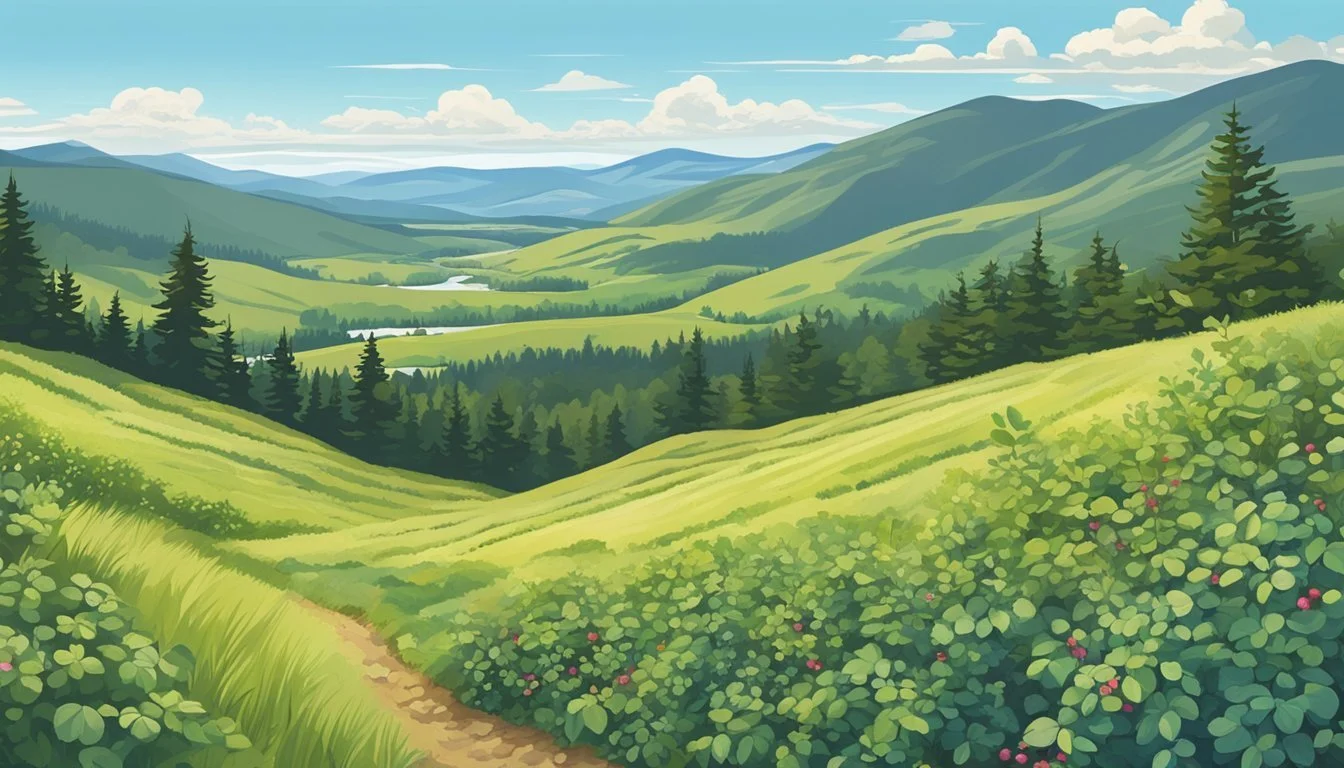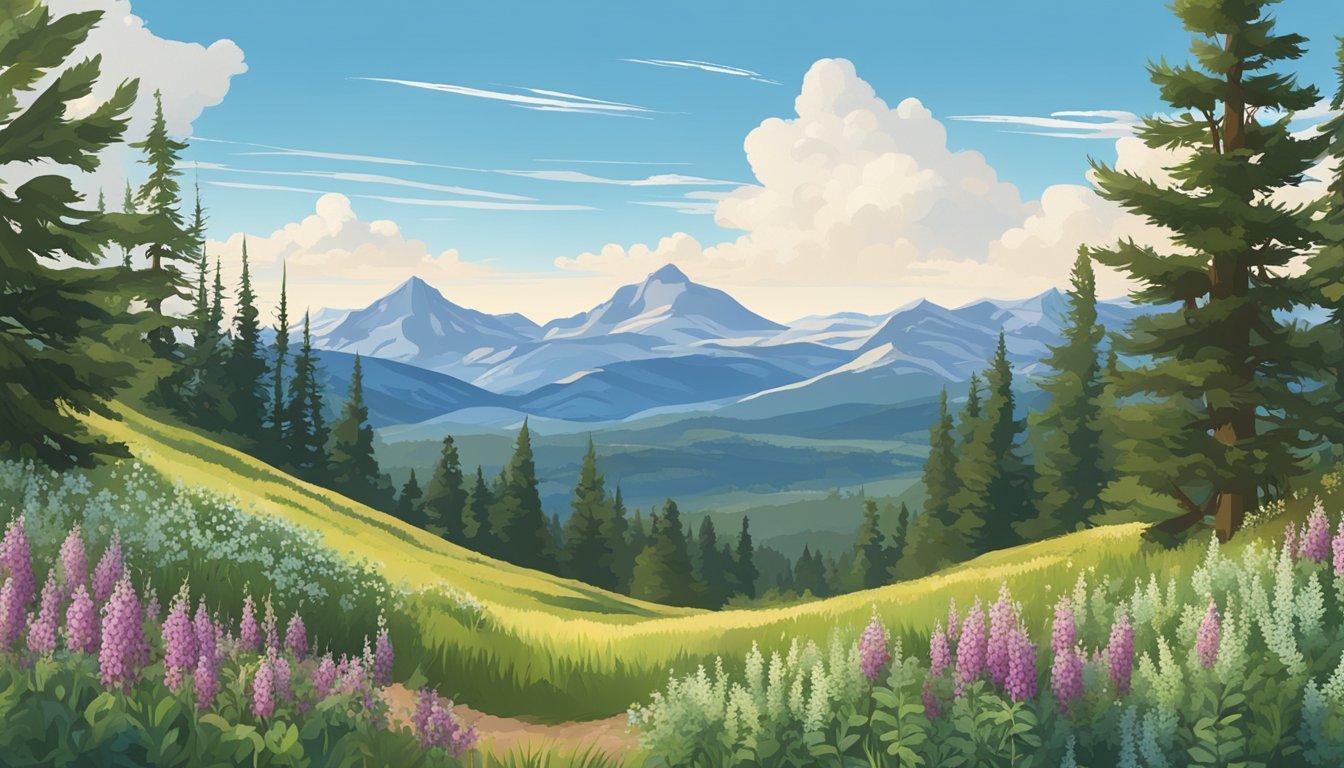Native Edible Plants in Montana
A Guide to Foraging and Cuisine
This Article is Part of Foraging Guide for All 50 US States
Montana's diverse ecosystem is home to a variety of native plants, many of which are edible and have been used for centuries by Indigenous peoples for their nutritional and medicinal properties. These plants not only offer a glimpse into the natural heritage of the region but also provide opportunities for foragers, gardeners, and enthusiasts to explore the state's flora. From the roots of the Camas plant to the berries of the Serviceberry, Montana's landscapes yield an abundant array of wild edibles that thrive across its prairies, mountainous regions, and river valleys.
Understanding the edible plants of Montana requires both respect for the environment and knowledge of each species' unique characteristics. With this understanding, one can safely forage and harvest these local resources. Key among these native species are the Bitterroot, historically a staple of Indigenous diets, and the chokecherry, whose fruit is often used in traditional recipes. People seeking to incorporate native plants into their diets are encouraged to learn about sustainable harvesting practices to ensure that these plants remain an integral part of Montana's biodiversity.
Recognition of edible plants in Montana goes beyond culinary use; it encompasses the cultural and ecological significance of the flora. Wild edibles like Huckleberries, not only staple foods for local wildlife but also enjoyed by Montanans, are celebrated with festivals that highlight their importance to local culture. By valuing and understanding the function and context of native edible plants, one contributes to the conservation and appreciation of Montana's natural heritage.
Interested in Mushroom Hunting in Montana?
Montana's vast wilderness, from the Rocky Mountains to the Great Plains, offers a diverse array of habitats for mushroom hunting. The state boasts edible species like morels, chanterelles, and king boletes. With proper identification skills and respect for public and private land regulations, foraging in Montana promises an unforgettable adventure.
👉 Guide on Mushroom Hunting in Montana
Historical Significance of Montana's Edible Plants
Edible plants have long been an integral part of Montana's history, providing sustenance and medicinal benefits to its early inhabitants. They are deeply woven into the cultural fabric of the region.
Early Inhabitants and Plant Use
The indigenous peoples of Montana developed extensive knowledge of local flora. They used plants like Camassia quamash (camas) and Shepherdia argentea (buffaloberry) for both food and medicine. One can trace their influence on the region primarily through these plants:
Camas: Roasted or boiled, the bulbs were a staple food.
Buffaloberry: Harvested for a variety of dishes and for medicinal purposes.
Bitterroot: Named Montana's state flower, it was a significant food source.
Serviceberry: Berries consumed fresh, dried, or mixed with game meat.
Cultural Traditions and Foraging
Montana's edible plants are not just passive food sources; they are active cultural symbols. Tribes such as the Blackfoot, Shoshone, and Salish have foraging traditions that are passed down through generations.
Blackfoot: For the Blackfoot, the gathering of Vaccinium membranaceum (huckleberries) was and still is a communal event.
Shoshone and Salish: These tribes teach the identification and harvesting methods of native plants, emphasizing respect for the land.
In conclusion, understanding edible plants through the lens of Montana's history is not merely botanical curiosity—it's acknowledging an enduring legacy.
Understanding Montana's Ecosystems
Montana's diverse ecosystems range from prairie grasslands to densely forested mountains, each supporting a unique array of native edible plants.
Prairie and Grasslands
Montana's prairie and grasslands are extensive, known for their vast open spaces and rolling hills. An important habitat, these grasslands house plant species well-adapted to the semi-arid climate. For example, prairie turnips (Pediomelum esculentum) and Camas (Camassia quamash) are rooted deeply within these ecosystems. They serve as traditional food sources for indigenous peoples and are resilient to the variable weather conditions.
Forests and Mountainous Regions
The forests and mountainous regions of Montana provide a contrasting habitat, with conditions favoring a different set of flora. Among the coniferous and deciduous trees, one can find huckleberries (Vaccinium spp.) and serviceberries (Amelanchier alnifolia), which thrive in the cool and moist environments. The forest floor is a forager's haven, but knowledge about the specific ecosystem is crucial to locate and correctly identify edible species.
Wetlands and Riparian Zones
Wetlands and riparian zones play a critical role in Montana's ecology, often being biodiversity hotspots. The water-rich soils support plants like cattails (Typha spp.) and watercress (Nasturtium officinale). These areas are lush and provide essential nutrients and water that support a wide range of plant and animal life, making them integral to the overall health of Montana's ecosystems.
Identifying Native Edible Plants
In Montana, foragers must recognize various native plants that are safe and nutritious to consume. Proper identification is crucial to avoid ingestion of toxic species.
Visual Guide to Plant Identification
Photographs and detailed descriptions are essential tools for accurately identifying edible plants in Montana. A field guide should feature high-quality images highlighting the distinctive characteristics of leaves, stems, flowers, and fruits. Notable Montana plants, such as the serviceberry and camas, are easier to identify with such visual aids.
Edible Trees and Shrubs
Trees and Shrubs: Key Species in Montana
Serviceberry (Amelanchier alnifolia): Recognizable by their small, round, dark purple fruits and white flowers.
Chokecherry (Prunus virginiana): Identified by their clusters of dark red to black cherries and elongated leaves.
When foraging for trees and shrubs, verify the leaf shape, fruit color, and bark texture. These features help distinguish edible species from inedible or harmful ones.
Edible Wildflowers and Herbs
Wildflowers and Herbs: What to Look For
Wild Mint (Mentha arvensis): Noticeable for its square stems and aromatic leaves.
Camas (Camassia quamash): Identified by their blue to purple flowers and grass-like leaves.
Wildflowers and herbs often require careful examination to ensure correct identification. Taste and scent can also be indicators, but should never be the only method used to identify a plant's edibility.
Nutritional and Medicinal Value
Native edible plants in Montana serve as vital sources of nutrition and have been used traditionally for their medicinal properties. These plants are often rich in essential vitamins and minerals necessary for human health.
Health Benefits of Wild Edible Plants
Wild Huckleberries: They are abundant in Vitamin C and Vitamin A, supporting immune function and vision health. Chokecherries, another Montana staple, not only offer a high content of antioxidants but are also a good source of potassium, necessary for maintaining proper heart and muscle function.
Plant Vitamin C Vitamin A Potassium Wild Huckleberry High High Moderate Chokecherry Moderate Low High
Traditional Medicinal Uses
Native tribes have utilized plants for centuries, recognizing their therapeutic benefits. Bitterroot, a well-known Montana plant, has been used traditionally to treat inflammation. This practice spotlights the plant's potential anti-inflammatory properties. Furthermore, the camas plant, rich in nutrients, has been used to aid with digestion and as a general health tonic, reflecting its diverse medicinal uses.
Sustainable Foraging and Conservation
Sustainable foraging ensures the conservation of Montana's habitats and native plants. Preservation efforts and ethical foraging practices work in tandem to maintain the delicate ecological balance.
Ethical Foraging Guidelines
Preparation: Foragers should educate themselves thoroughly about native species and their lookalikes to avoid harvesting non-target plants.
Permitting: Always adhere to local regulations that may require permits for foraging certain plants.
Quantity: Limit the harvest to ensure plant populations can regrow. A common guideline is to take no more than 20% of the available plants in one area.
Seasonality: Harvest plants during the appropriate season and phase of growth to minimize impact.
Habitat Preservation Efforts
Restoration Projects: Active restoration of disturbed habitats helps conserve plant diversity. Foragers should participate in or support these initiatives.
Protected Areas: Support legislation that designates protected areas within Montana to conserve critical habitat for native plants.
Monitoring: Foragers can contribute to conservation by reporting their observations of plant abundance and conditions to local environmental organizations.
Culinary Uses of Montana's Edible Flora
Montana's diverse landscapes are home to an array of wild, edible plants that offer a natural bounty for foragers and culinary enthusiasts. These native species can be transformed into a variety of palatable dishes, teas, jams, and preserves.
Cooking with Wild Plants
Foraging for edible plants allows one to incorporate wholesome and organic ingredients into their meals. Chokecherries, abundant in Montana, can be used in savory sauces for meats or turned into a robust wine. The versatile Camas root, once a staple food for Native Americans, can be roasted or boiled and has a flavor akin to sweet potato. For a green addition, one might consider the stinging nettle, which should be cooked to remove the stinging hairs, and can be used like spinach in dishes.
Wild Plant Preparation Method Suggested Use Chokecherries Boiled and strained Sauces, wines, syrups Camas Root Roasted or boiled Substitute for potatoes, sweeteners in baking Stinging Nettle Boiled to remove stinging Soups, pesto, infused into oils
Recipes for Jams, Teas, and Preserves
Montana's edible flora inspires a range of delightful recipes for jams, teas, and preserves. Wild Huckleberries make for a sweet and tart jam that pairs well with fresh bread or desserts. They can also be dried and stored for later use. The fragrant and calming mint species found in Montana are perfect for brewing into a refreshing tea. Wild rose hips, high in vitamin C, can be used in preserves and are especially comforting during Montana's cold winters.
Wild Huckleberry Jam
Ingredients: Huckleberries, sugar, pectin (how long does pectin last?)
Method: Mash berries, combine with sugar and pectin, boil, and can
Montana Mint Tea
Ingredients: Fresh mint leaves, hot water
Method: Steep mint leaves in hot water for several minutes
Rose Hip Preserves
Ingredients: Rose hips, sugar, lemon juice
Method: Simmer rose hips with sugar and lemon juice, puree, and can
Gardening with Native Species
Gardening with native species in Montana offers the double benefit of creating beautiful landscapes and providing natural habitats for local wildlife. These plants have evolved to thrive in the region’s distinct climate and soil conditions.
Landscaping with Edible Plants
When incorporating edible plants into landscaping, one must select species that are well-suited to Montana’s climate. Serviceberry (Amelanchier alnifolia), for example, provides showy flowers and edible berries. Native Wild Strawberries (Fragaria virginiana) can serve as an excellent groundcover, offering sweet fruits in return. Using these plants, gardeners not only add aesthetic value to their property but also enjoy the bounty of fresh fruits.
Edible Native Plants Season Characteristics Serviceberry Spring-Summer Edible purple berries, white flowers Wild Strawberry Summer Edible red berries, groundcover Chokecherry Summer Edible red to black berries, used in jams Saskatoon Berry Summer Edible purplish-blue berries, for fresh eating or pies
Creating Wildlife-Friendly Gardens
A wildlife-friendly garden uses native plants to create an ecosystem that supports birds, bees, butterflies, and other local fauna. Plants like the Bitterroot (Lewisia rediviva), which is Montana's state flower, offer nectar and pollen to insects, while Beargrass (Xerophyllum tenax) provides foliage for small mammals. Keeping these plants free from pesticides ensures a safe environment for wildlife visitors. A diverse assortment of native plants with different blooming periods can ensure year-round food and shelter.
Early Bloomers: Oregon Grape (Mahonia aquifolium), Arrowleaf Balsamroot (Balsamorhiza sagittata)
Mid-Season Bloomers: Pearly Everlasting (Anaphalis margaritacea), Blanketflower (Gaillardia aristata)
Late Bloomers: Goldenrod (Solidago spp.), Asters (Symphyotrichum spp.)
In both landscaping and creating wildlife-friendly spaces, it’s important to recognize that native plants require minimal irrigation, reduce the need for fertilizers, and provide a low-maintenance option for gardeners in Montana.
Seasonal and Geographical Availability
In Montana, the availability of native edible plants varies with seasons and geography. Certain plants thrive in the varied climates of the region's mountains, plains, and valleys, with summer and autumn being particularly rich in harvest.
Summer Bounty
During summer, Montana's landscape offers an array of edible plants, favoring the forager with a diversity of habitats ranging from wetlands to dry prairies. Wild berries such as huckleberries and chokecherries are plentiful in mountainous areas, reaching peak ripeness in mid to late summer.
Serviceberries: Found in open forests and along streams.
Wild Strawberries: Thrive in open woodlands and meadows.
In lower altitudes and grasslands, one can gather various wild greens and herbs:
Lamb's quarters: Grow in disturbed soils throughout the state.
Wild Mint: Loves the moist soil near streams and rivers.
Autumn Harvesting
As autumn approaches, the focus shifts to roots and tubers that store well into the winter months. Geographical conditions such as soil type and elevation influence the growth and flavor of these plants.
Plant Habitat Harvest Time Camas Wet meadows Late September Bitterroot Dry, rocky slopes Early Autumn Prairie Turnip Grasslands September-October
In forested areas, pine nuts from the Ponderosa Pine become available and are esteemed for their high caloric content. They are typically harvested in early autumn when cones open to release the seeds.
Challenges and Threats
Native edible plants in Montana face various challenges and threats that risk their survival and accessibility. These challenges significantly affect biodiversity, ecosystem stability, and the cultural traditions of indigenous populations who rely on these plants.
Impact of Fire and Climate Change
Fire is a natural part of many ecosystems, including Montana's, but increased frequency and intensity of wildfires pose significant risks. Climate change exacerbates this threat by altering precipitation patterns and increasing temperatures, leading to:
Drier conditions, making forests more susceptible to large fires.
Shifts in plant zones, with some native edible plants losing their habitat range and new competitors moving in.
Climate change also affects plants' phenology, the timing of seasonal activities like flowering and fruiting. Changes in these cycles can disrupt the synchronicity between plants and pollinators, further threatening food sources.
Invasive Species Management
The spread of invasive species displaces native edible plants by:
Competing for essential resources like light, water, and nutrients.
Altering soil chemistry or structure to the detriment of native species.
Efforts to manage invasive species need to balance the preservation of ecosystems with the protection of traditional food sources. Success in managing invasive species often includes strategies like:
Strategy Description Mechanical removal Physical removal of invasive plants to reduce their spread. Biological control Introduction of natural predators or competitors to invasive species. Chemical treatments Application of herbicides in a controlled manner. Restoration of native species Reintroduction of native plants to restore the natural balance.
These strategies are executed with the goal of minimizing damage to native plants and supporting the resilience of Montana's ecosystems.
Future Perspectives
The successful harnessing of native edible plants in Montana hinges on dedicated research efforts and comprehensive education, coupled with robust community engagement.
Research and Education
Continued research is crucial in understanding the nutritional potential and ecological impact of Montana's native edible plants. Universities and research institutions are working to identify species that can be sustainably harvested or cultivated on a larger scale. Such research often leads to the development of educational programs aimed at disseminating knowledge about these species, both in academic settings and to the general public.
Key Research Entities:
Local Universities
Agricultural Research Services
Current Focus Areas:
Plant propagation techniques
Nutritional analyses
Sustainability studies
Community Involvement and Events
Community involvement is the cornerstone of integrating native edible plants into Montana's food systems. Local organizations often host events such as workshops, foraging tours, and cooking classes to encourage hands-on learning and appreciation of these plants. These events serve as platforms for sharing knowledge, experience, and recipes, thereby fostering a community-centric approach to conservation and use of native edibles.
Upcoming Community Events:
Wild Food Walks
Native Plant Harvest Festivals
Community Goals:
Increase public awareness and interest
Promote conservation efforts through participation
Conclusion
Montana's natural heritage includes a remarkable variety of native plants that have sustained its ecosystems and human inhabitants for centuries. Through conservation efforts, these plants play a pivotal role in promoting biodiversity and ecological sustainability. The indigenous flora offers not only diverse habitats for wildlife but also nutritional and medicinal benefits for humans.
Conservation Strategies:
Promotion of native species in landscaping
Protection of wild plant populations
Encouragement of ecological farming practices
Sustainability:
Use of native plants reduces the need for fertilizers and pesticides.
Native vegetation supports soil health and water conservation.
Locally adapted plants aid in maintaining Montana's natural balance.
Embracing Montana’s native plants supports the local ecosystem. It is critical for individuals and communities to recognize these species' value and to participate actively in their preservation.
Key Native Edible Plants:
Camas (Camassia quamash)
Chokecherry (Prunus virginiana)
Serviceberry (Amelanchier alnifolia)
A collective focus on sustainable practices ensures the resilience of native plant species, which in turn maintains the health of Montana's unique landscapes. It encourages a harmonious relationship between humans and their environment, respecting the intricate web of life that characterizes the region.





